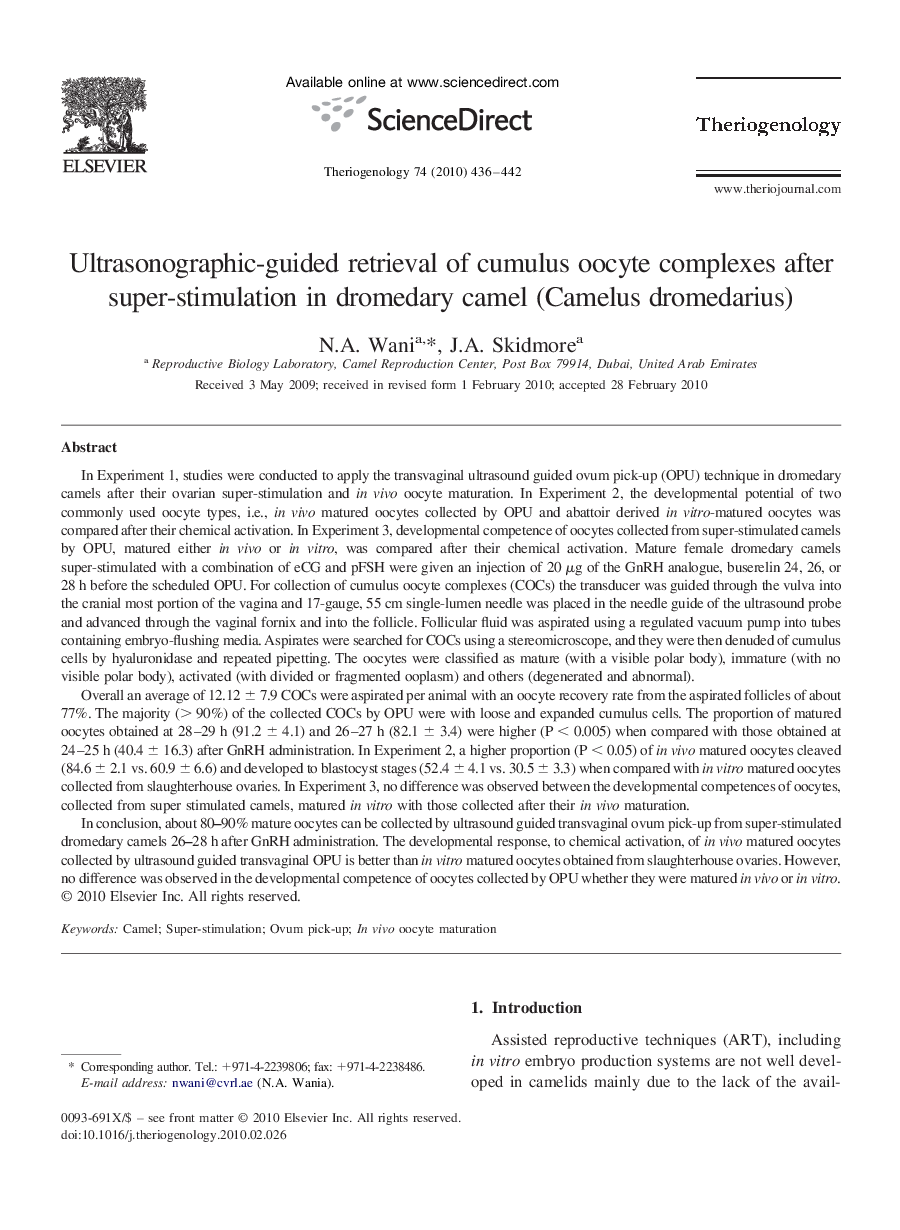| کد مقاله | کد نشریه | سال انتشار | مقاله انگلیسی | نسخه تمام متن |
|---|---|---|---|---|
| 2097875 | 1082570 | 2010 | 7 صفحه PDF | دانلود رایگان |

In Experiment 1, studies were conducted to apply the transvaginal ultrasound guided ovum pick-up (OPU) technique in dromedary camels after their ovarian super-stimulation and in vivo oocyte maturation. In Experiment 2, the developmental potential of two commonly used oocyte types, i.e., in vivo matured oocytes collected by OPU and abattoir derived in vitro-matured oocytes was compared after their chemical activation. In Experiment 3, developmental competence of oocytes collected from super-stimulated camels by OPU, matured either in vivo or in vitro, was compared after their chemical activation. Mature female dromedary camels super-stimulated with a combination of eCG and pFSH were given an injection of 20 μg of the GnRH analogue, buserelin 24, 26, or 28 h before the scheduled OPU. For collection of cumulus oocyte complexes (COCs) the transducer was guided through the vulva into the cranial most portion of the vagina and 17-gauge, 55 cm single-lumen needle was placed in the needle guide of the ultrasound probe and advanced through the vaginal fornix and into the follicle. Follicular fluid was aspirated using a regulated vacuum pump into tubes containing embryo-flushing media. Aspirates were searched for COCs using a stereomicroscope, and they were then denuded of cumulus cells by hyaluronidase and repeated pipetting. The oocytes were classified as mature (with a visible polar body), immature (with no visible polar body), activated (with divided or fragmented ooplasm) and others (degenerated and abnormal).Overall an average of 12.12 ± 7.9 COCs were aspirated per animal with an oocyte recovery rate from the aspirated follicles of about 77%. The majority (> 90%) of the collected COCs by OPU were with loose and expanded cumulus cells. The proportion of matured oocytes obtained at 28–29 h (91.2 ± 4.1) and 26–27 h (82.1 ± 3.4) were higher (P < 0.005) when compared with those obtained at 24–25 h (40.4 ± 16.3) after GnRH administration. In Experiment 2, a higher proportion (P < 0.05) of in vivo matured oocytes cleaved (84.6 ± 2.1 vs. 60.9 ± 6.6) and developed to blastocyst stages (52.4 ± 4.1 vs. 30.5 ± 3.3) when compared with in vitro matured oocytes collected from slaughterhouse ovaries. In Experiment 3, no difference was observed between the developmental competences of oocytes, collected from super stimulated camels, matured in vitro with those collected after their in vivo maturation.In conclusion, about 80–90% mature oocytes can be collected by ultrasound guided transvaginal ovum pick-up from super-stimulated dromedary camels 26–28 h after GnRH administration. The developmental response, to chemical activation, of in vivo matured oocytes collected by ultrasound guided transvaginal OPU is better than in vitro matured oocytes obtained from slaughterhouse ovaries. However, no difference was observed in the developmental competence of oocytes collected by OPU whether they were matured in vivo or in vitro.
Journal: Theriogenology - Volume 74, Issue 3, August 2010, Pages 436–442